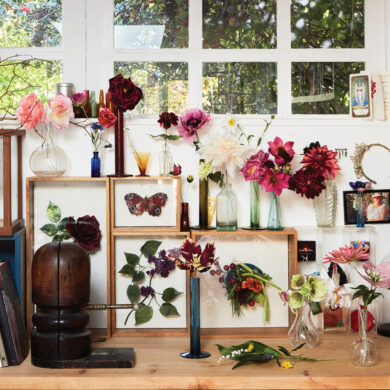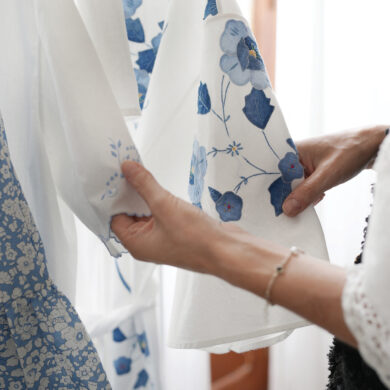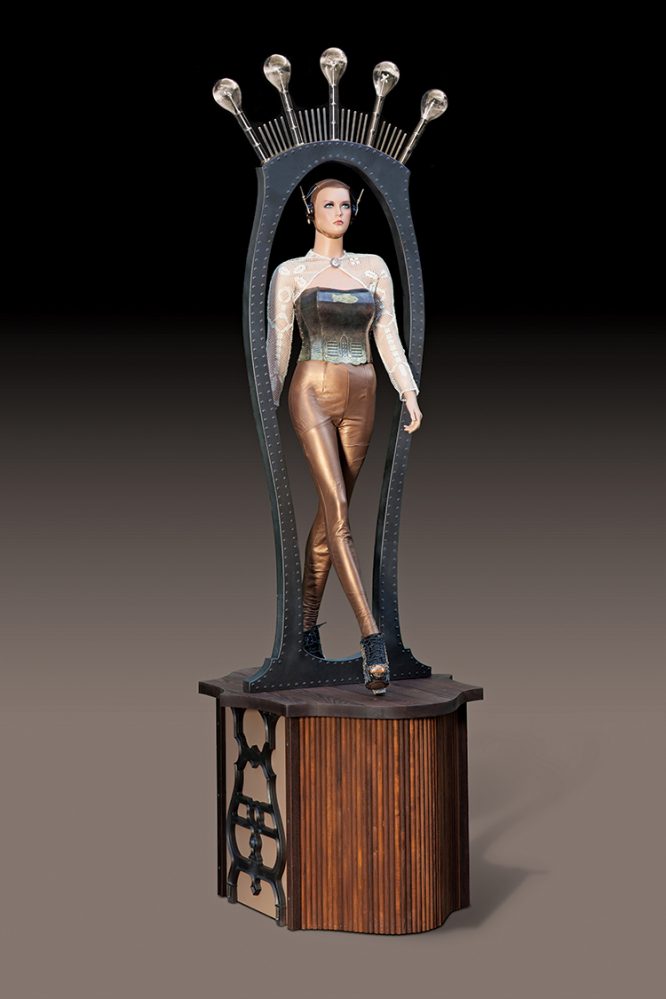
One Giant Step
Size: 84″ × 36″
In 2016, we were invited to participate in a show at the Fuller Craft Museum in Brockton, MA, near Boston. I came up with a concept that would showcase Ruth’s fashion skills. The centerpiece was a woman stepping through a portal from the past into the future. Ruth created pearlized leather pants, an etched copper bustier, and a bolero jacket made from a crocheted tablecloth. The big “WOW” occurred when Ruth created these over-the-top, bead-embroidered high heel platform shoes. We didn’t know it then, but that was the birth of Shoetopia.
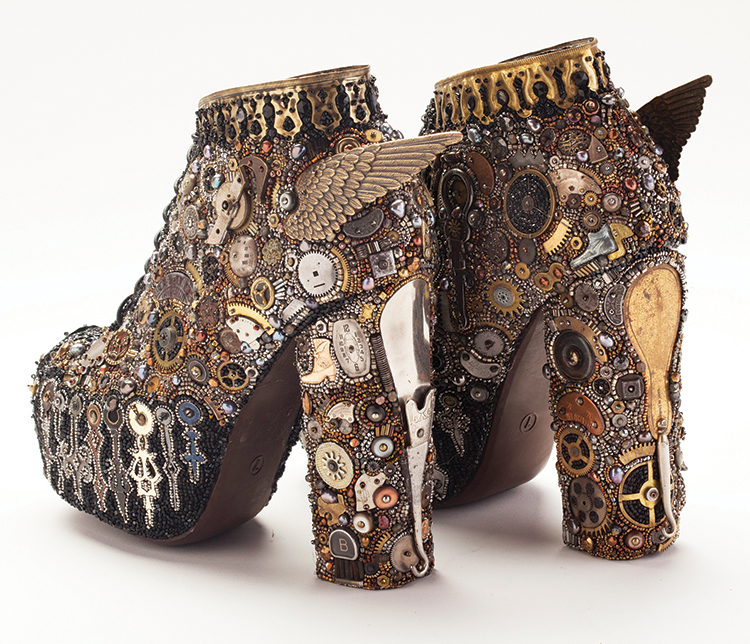
In These Shoes?
These high-heel platform shoes are covered with clock parts, shoe buttons, button hooks, shoehorns, shoe polish cans, subway tokens, typewriter keys, oil lamp parts, and thousands of mostly antique beads that are sewn on by hand. The six-foot-tall figure stood on a platform that elevated it three feet above the floor. This enabled museum goers to get really close to the shoes. A chorus of OMGs and flickering iPhones usually followed.
We worked together for nine months creating five pieces for the New Sole of the Old Machine: Steampunk Brockton Show. We came away from it knowing that we had created a unique style that people responded to.
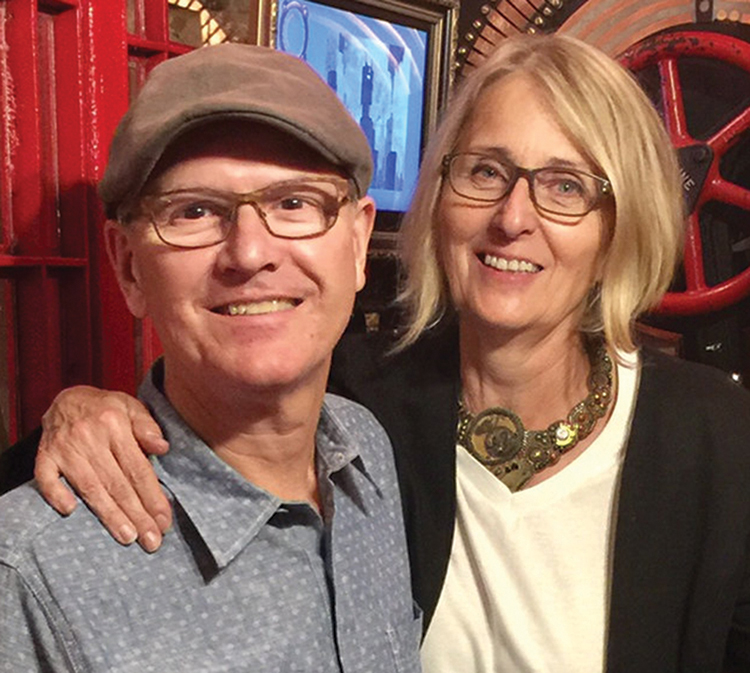
Regardless how you feel about our work, you probably haven’t seen anything quite like it before. It’s hard to copy because it takes a diverse skill set and considerable patience to execute.
Ruth
Growing up on the south coast of Oregon with a creative, artistic mother gave me a strong foundation for my current artwork. She taught me a variety of techniques, many of which I continue to develop and use to this day. For a dozen years in the ‘80s and ‘90s, I used the sewing skills she taught me as I professionally created reverse appliqué leather clothing and expanded that into the sale of home goods. In the last 15 years, I’ve learned bead embroidery, paperclay sculpture of dolls and animals, metal etching, collage with antique documents, and bookmaking, which I learned from fellow artist Sharon Payne Bolton. My favorite projects are the ones that incorporate more than one skill.
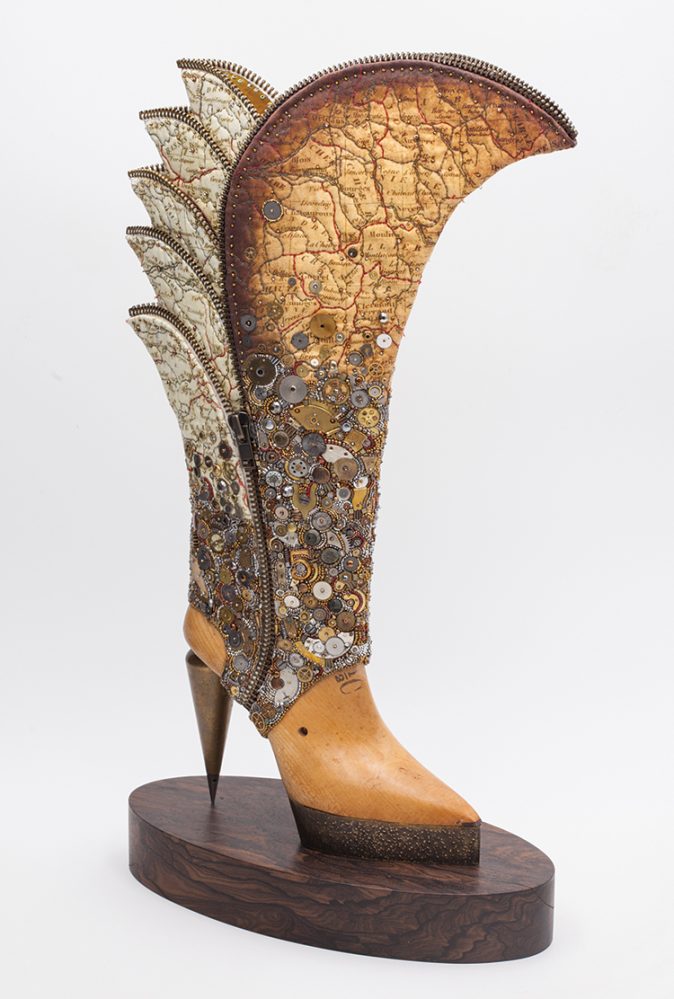
Finding someone as talented as my husband, Jim, has continued to challenge me and expand my creative possibilities. I’m aware how rare it is for a couple to share such an intense desire to create art and even more rare to share the processes of creating. I feel fortunate that our skill sets don’t overlap and that we can support each other’s work.
The Highwalker
Size: 42″ × 22″ × 12″
This concept was inspired by houseplants like the sansevieria and the yucca plant. Some test pieces were created out of epoxy clay wrapped around insulated electrical wire. Epoxy clay dries as hard as a rock but is easily shaped with a rasp and is easily sanded. This shoe last is unusually large for a woman, maybe a size 12, and that gives it a real presence. The heel is made from a fire hose nozzle and a billiard ball. The platform sole is covered with embossed clay.
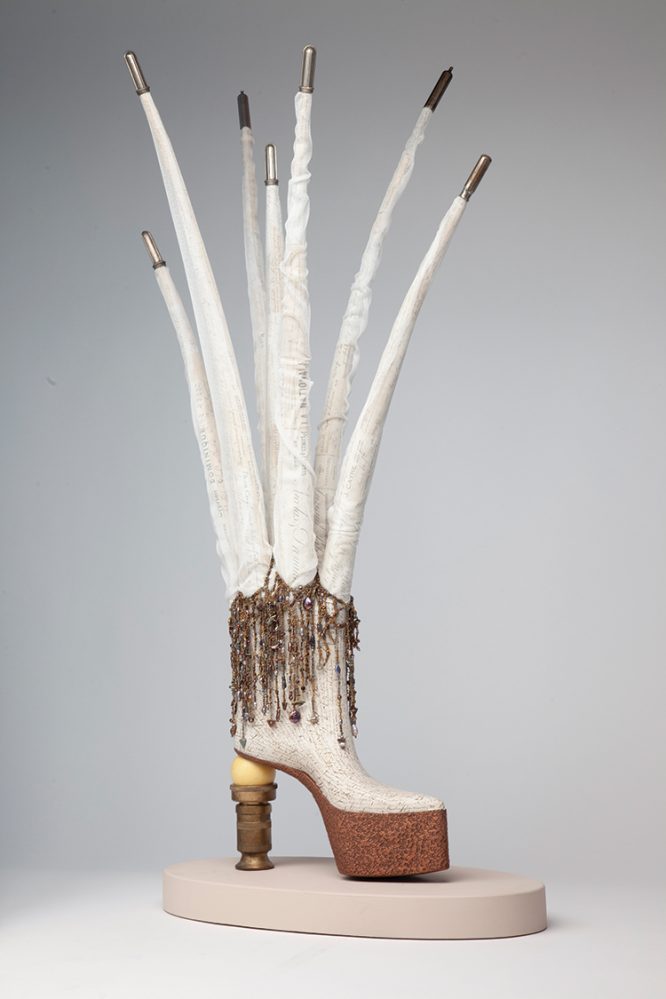
Jim
I was drawing before I learned to read or write. Art has always been a key component in how I identify myself. As a child in school, I was average at everything. I went to a small rural parochial school where two or three grades were taught in the same room. So when the other grade was being taught, the rest of us were supposed to study. To my delight, that same pencil that wrote out arithmetic problems could be put to better use drawing the spaceship that would help me escape to another world. Art was usually the last class of the afternoon, so my day would end on a high note.
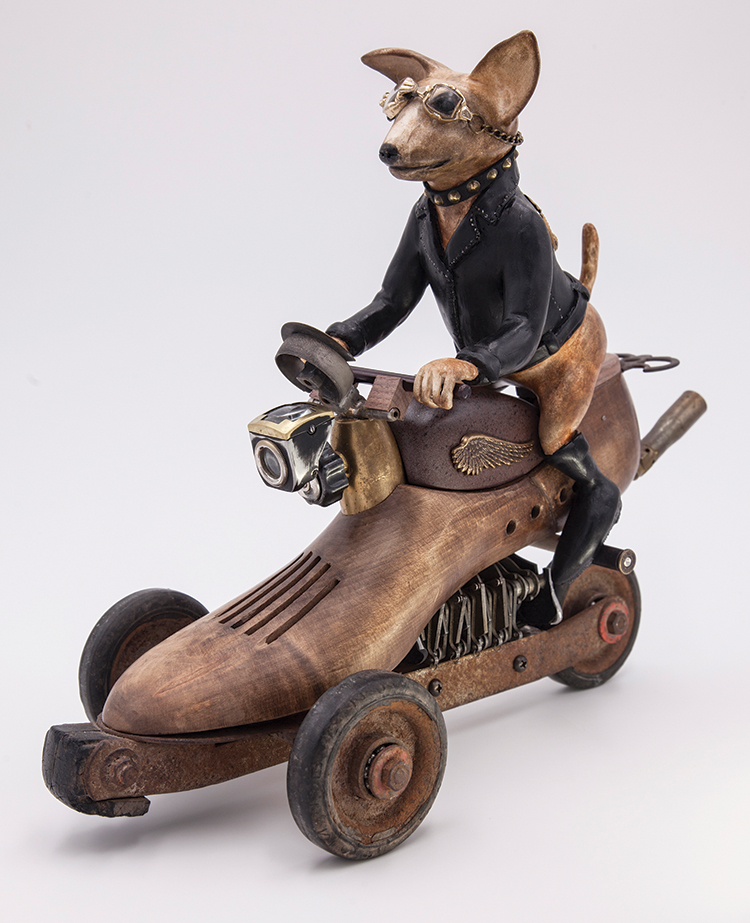
I had the good fortune to go to a public high school that had an amazing art program in my hometown of Monett, Missouri. My luck continued when I chose to attend Missouri State University in nearby Springfield. I didn’t know the first thing about picking a college, but I landed in one with a superb art and design program. Art education transported me from rural farm boy to Vice President of a Fortune 500 company where we made games. My career was better than anything I could have imagined as a kid.
Bird Boot Bangle
Size: 14″ × 8″ × 2.5″
Created from a wooden shoe last (a hardwood maple form that leather shoes were made on through the 1970s; today, plastic forms are more commonly used). In addition, a radio dial plate, beaded purse frame, oil lamp parts, antique found objects including clock parts, music box parts, button hook, buttons, and bead embroidery round out the piece.
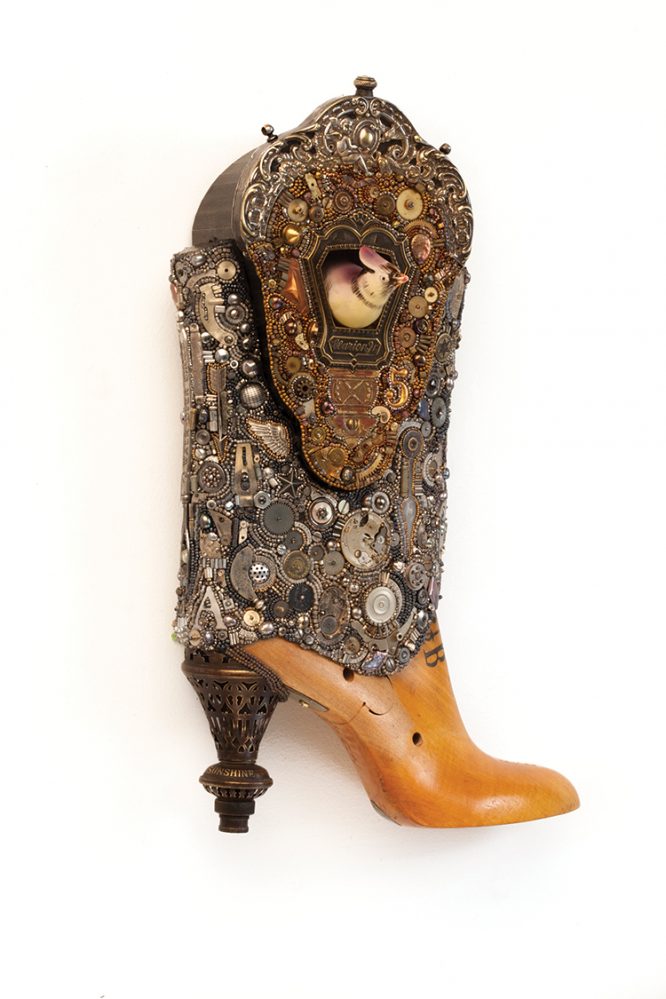
Shoetopia
Ruth and I have chosen many different creative paths in life, both jointly and separately. Sometimes you have to be on the path for a while before you can know what the opportunity is and that it leads somewhere. We don’t have a blueprint.
In our hometown of East Longmeadow, MA, the town center is built around a traffic rotary where seven streets converge. It sounds messy, but with a little attention and cooperation, everyone gets to where they are going. I think that’s a good analogy of how Shoetopia came to be. It took a convergence of a wide variety of skills to make this happen. Skills were developed over many years while exploring numerous creative paths. Between us, we counted seven in all, including: bead embroidery, sewing fabric and leather, paper collage, metal etching and texturing, woodworking, sculpting with paperclay, and Adobe Photoshop and Illustrator.
While we can both point to accomplishments from these various individual skills, it is the combined set that produced this unique body of work.
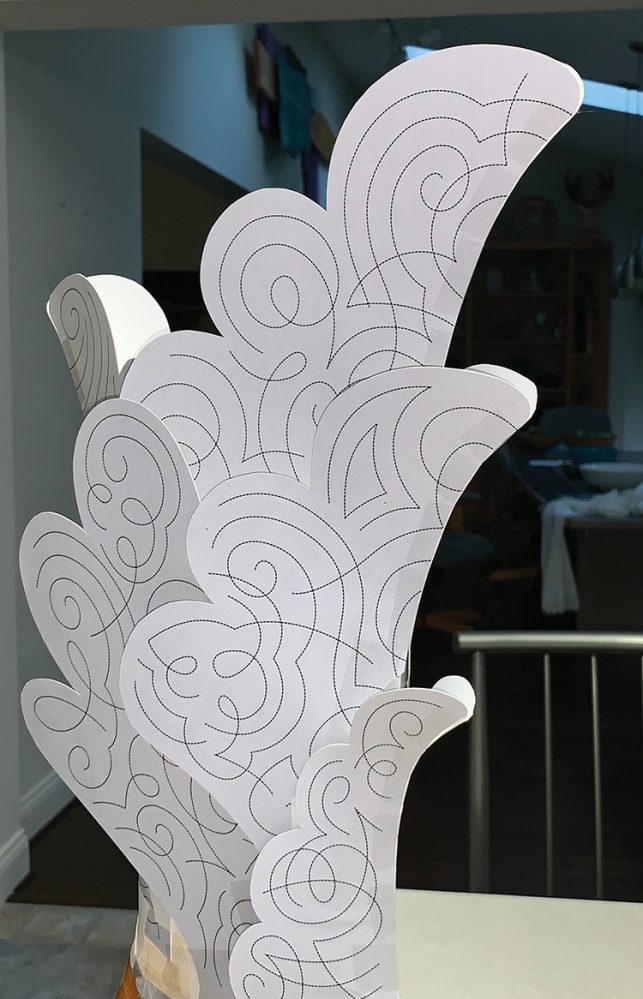
DETAILS of WALK IN THE CLOUDS
The upper boot consists of nine sections of quilted and beaded fabric that were lined in leather. To support the panels, a material needed to be sandwiched inside for support, and it needed to be stiff but flexible. The solution was found in a kitchen drawer — a package of thin, plastic cutting board mats. They were easy to cut with scissors, and tiny holes were punched along the outer edge where they could all be stitched together. If no solution exists, invent one.
Approximately 9 years ago, Ruth purchased a wholesale lot of about 200 Larimar cabochons from the Dominican Republic that would today retail for about $2000+. She made a couple of bracelets using some of them, while the remainder spent years in a flat drawer waiting their fate. Three boots had been completed at this point, and one day, I was looking through her collections for ideas and said, “Why not use these for one spectacular piece.” I thought, “There’s only one other person crazy enough to do something like this, and I’m married to her.” Don’t save the good stuff for that special piece; make everything you do special.

Walk in the Clouds
Size: 26″ × 6″ × 13″
This boot features about 100 Larimar cabochons in a bead-embroidered cluster. The upper section is a hand-dyed fabric that is quilted with antique steel beads; a painted wood shoe last is complemented by a gilded sole and bronze cast heel.
When you walk away from a challenge, you deny yourself the satisfaction of accomplishment.
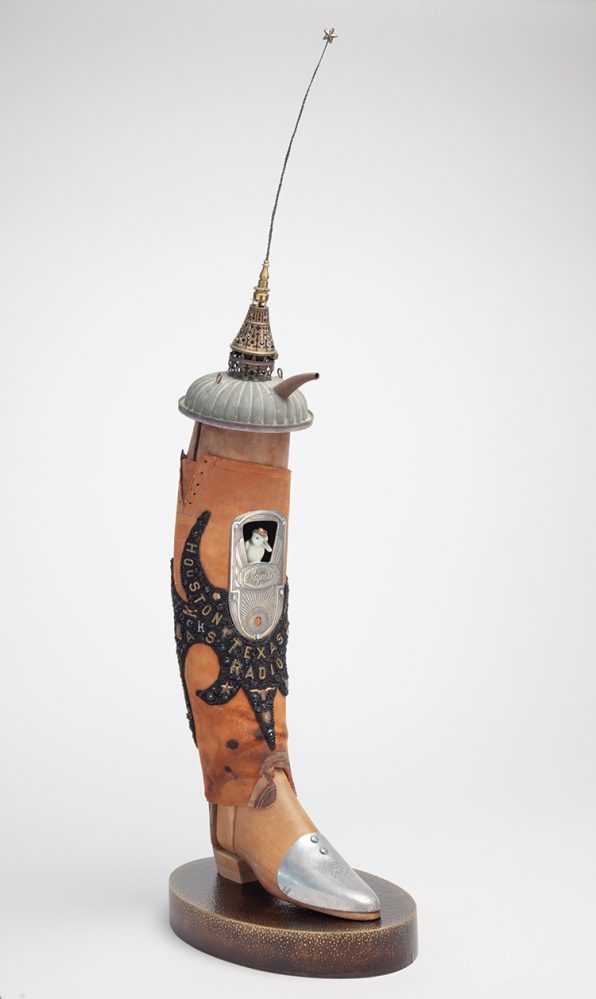
Radio Free Texas
Size: 40″ × 9″ × 14″
Built over a wood riding boot tree, this piece features all-black vintage beads embroidered around brass letters that spell cities in Texas. The silver plate in the center is from a 1930s-era radio dial plate, which is now the home of a little bird disc jockey wearing a cowboy hat. The boot is capped with a metal oil can top and a wire antenna with a Texas star at the end.
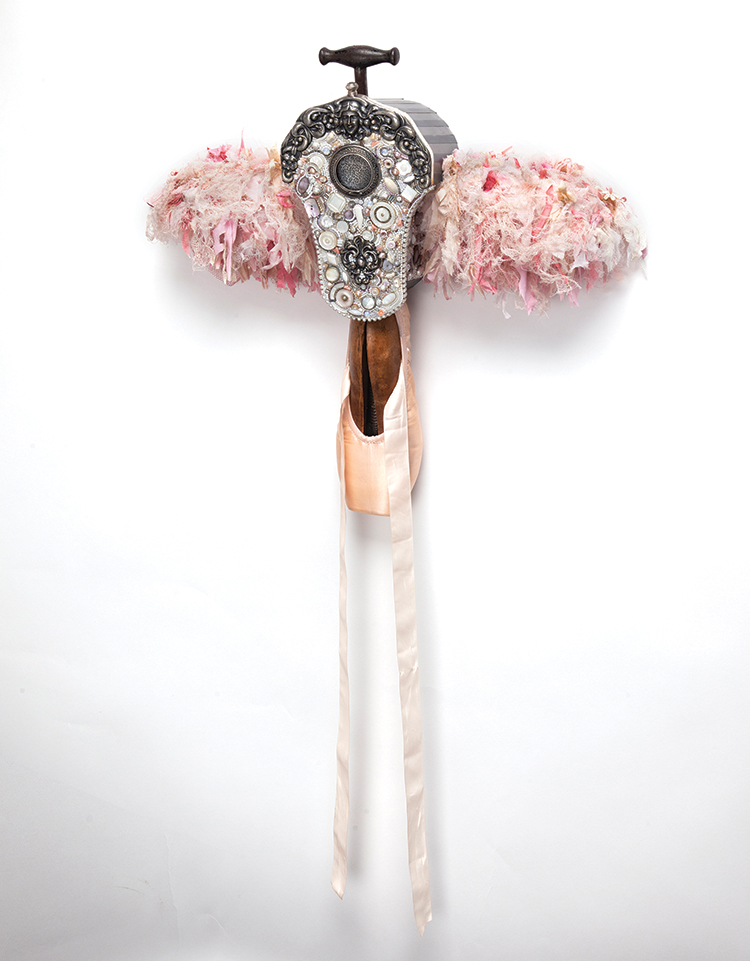
Tortured Ballet
Size: 20″ × 15″ × 6″
A vintage shoe stretcher and ballet shoe were combined with a bead-embroidered bird house. Frayed fabric wings were added to give the appearance of a tutu.
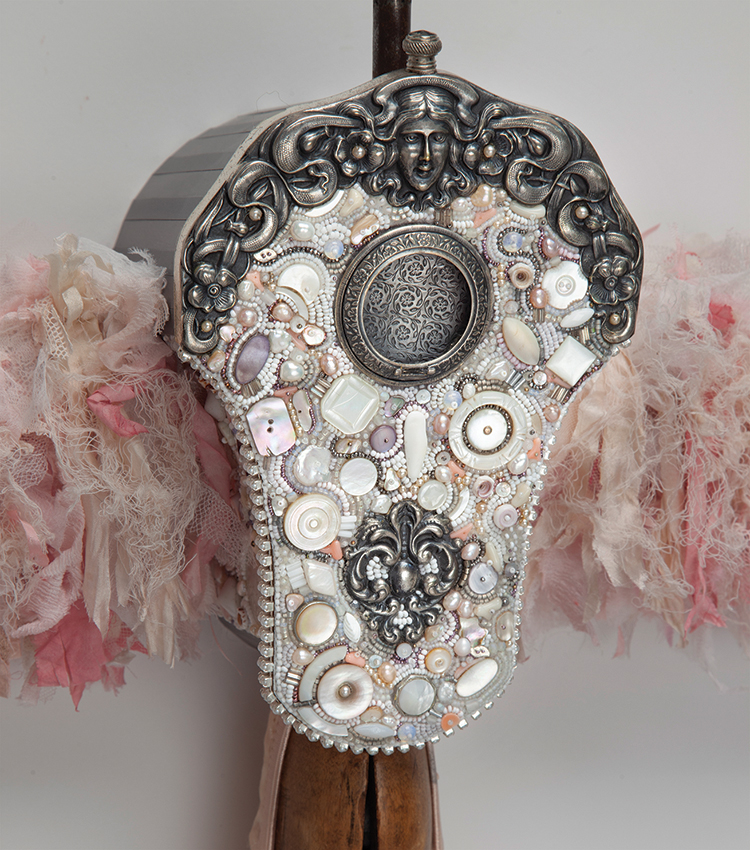
Recent work has tended to take on a brassy brown and gold color palette. For Tortured Ballet, a white and pink color palette was chosen. White buttons, mother of pearl ornaments, and pearl beads took center stage. While the other pieces are clearly defined as shoes, in this, the shoe is merely a shape in an unconventional assemblage of textures and surfaces. This departure would carry forward into the work that followed.
We are often asked how we are able to get along with each other and work together so well. I think the biggest reason is because our skills don’t overlap. I have no idea of what to do with a sewing machine. I doubt that I would get past threading the needle. On the other hand, I’m pretty good at Photoshop, and I use it regularly to visualize and plan the pieces we build.
We have to rely on each other to make this work. At the root of all of this is a real love and admiration of each other’s work. We are both driven to do the best we are capable of and then push a little beyond that. Ruth will not hesitate to take something apart and redo it if she doesn’t like it, and I’m the same way. I’m probably the most vocal critic. Sometimes it’s easier to get along with people if you just praise them and tell them what they want to hear. If you want to be a real professional, though, you have to know how to give and take constructive criticism. I think Ruth and I both buy into the idea that the degree to which you overcome a challenge is proportional to the joy you experience in a successful result. There is nothing better than sharing that experience.
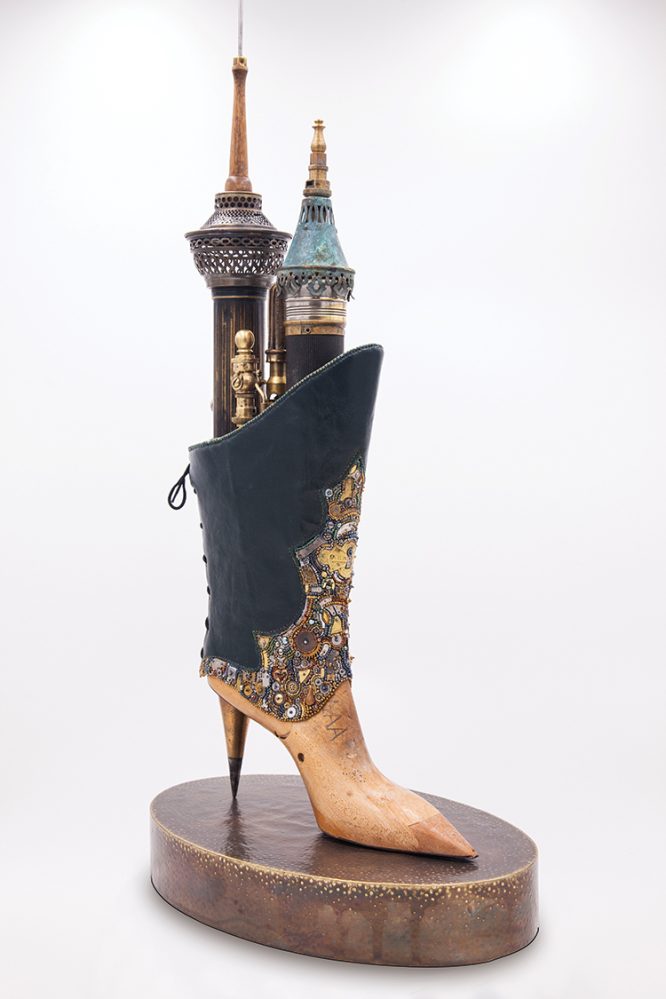
Stiletto Towers
Size: 24″ × 8″ × 12″
This high-heel boot with protruding city towers features a bead-embroidered surface made from clock parts, trinkets, and other found objects. The boot is built over a 1950s-era wooden shoe last. The heel is a brass surveyor’s plumb bob. The towers are 1950s-era brass flashlights with gas lamp parts, tire valve covers, oilers, brass finials, and a wood-handled awl.
This concept features a strong emphasis on leather as the primary material. Wood shoe lasts are easy to find on eBay, but you rarely see a high heel with a sharp pointed toe like this one. The spiked heel was a natural fit. The towers were inspired by architecture in Barcelona. We had recently found two old metal flashlights at Brimfield Antique Fair, which fit perfectly with some oil lamp parts. The cylindrical shapes are mounted over wood dowel rods, nested into the wooden structural core.
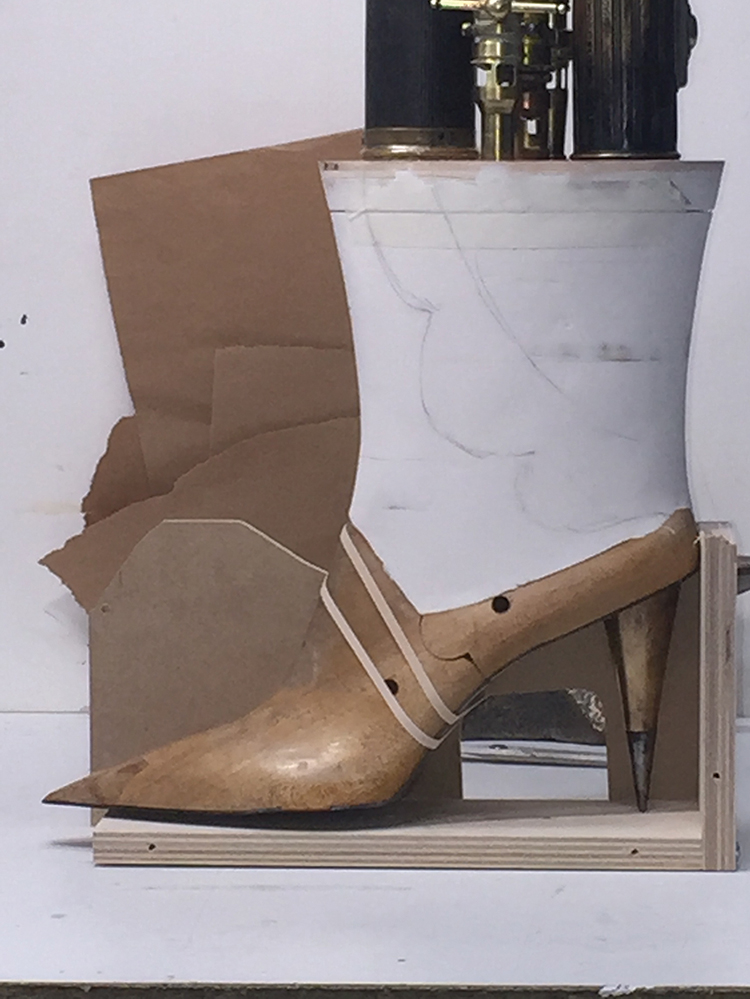
A structural core has to be created for a boot like this before the surface pieces can be attached. A series of 3/4″ plywood ovals were cut and stacked onto two steel rods that mount into the wooden shoe last base. They were coated with a layer of epoxy clay and, when dry, were shaped with rasps and sandpaper. A form is then ready for the surface pieces to be designed. Shapes are drawn and cut from paper tag stock to make the various pieces. The shapes are then attached to the boot core with rubber bands and tape and reworked until they look right. After marking and photographing the mockup, it’s disassembled, and the pieces are used as patterns.
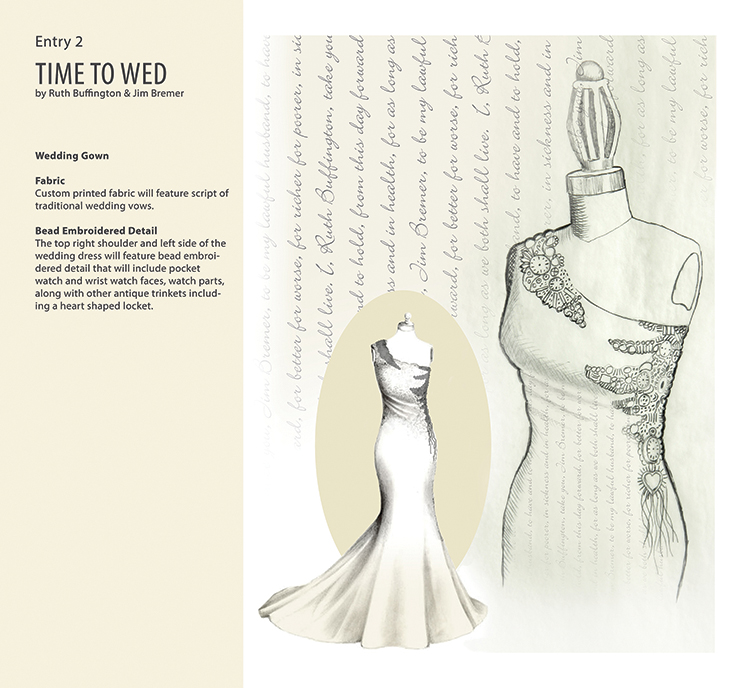
Time to Wed
Size: 72″ × 30″
The wedding dress is made of custom printed fabric featuring the wedding vows of its creators. It is embellished with antique clock parts and bead embroidery. The crown and veil are copper with a variety of antique clock hands
Why shoes? As the saying goes: “one thing leads to another.” In 2016, there was a call for artists to submit ideas to our local Springfield Art and History Museum for an upcoming Steampunk Show. Ruth was interested, but sketching and proposals are not typically part of her process, and she asked me to help. I worked my entire career in the graphic arts field, where concept sketches and proposals were part of my everyday life. We brainstormed some ideas, and I pieced together a presentation of three fashion-related pieces highlighted by a steampunk wedding dress. All three made it into the show, and the wedding dress won a prize as the People’s Choice Award. This marked a big leap forward for the intricate combination of bead embroidery and found objects that Ruth had previously only done as jewelry. This was something truly different. Now, this unique combination of elements would embellish and take center stage on a fashion item.
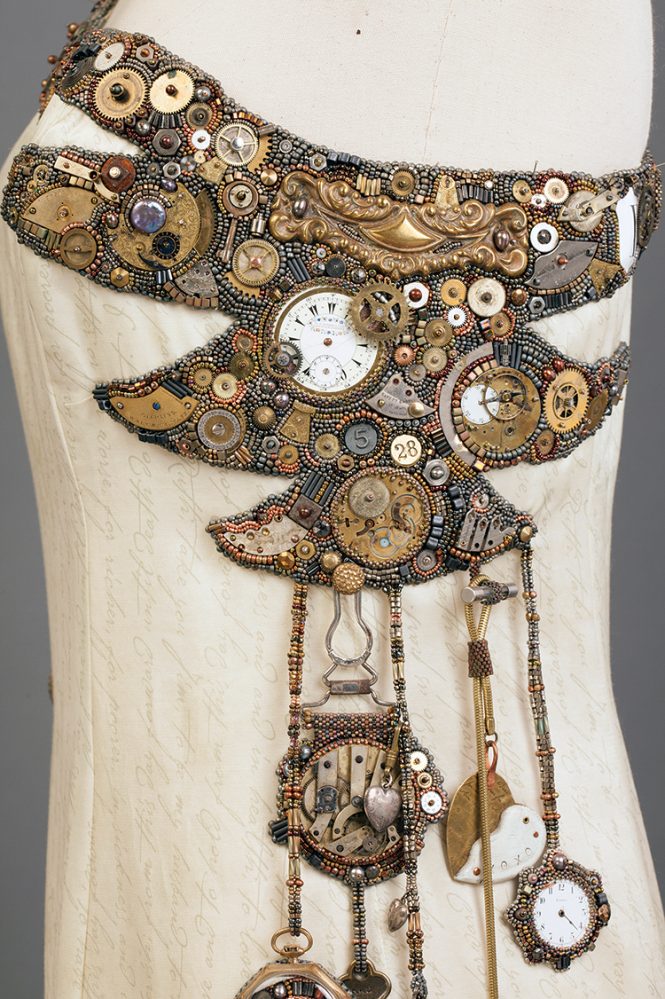
I had never done anything in fashion design but now found myself doing just that. Ruth had done numerous leather jackets and other custom fashion items over the years and won awards for them; now, she was able to take my sketches and turn them into professionally fitted items. The icing on the cake, of course, was the amazing surface design and embellishments that she created to distinguish the work. While I feel Ruth deserves most of the credit for the outcome, I felt for a while that her work could be more than crafted jewelry and be elevated to works of art. I can’t say that I have doled out a lot of good advice in my time, but in this case, I was spot on. This is what I love about collaboration. Sometimes a second pair of eyes and a few words of encouragement can make big things happen. It works the other way, too. It’s great having Ruth as my personal in-house art consultant.
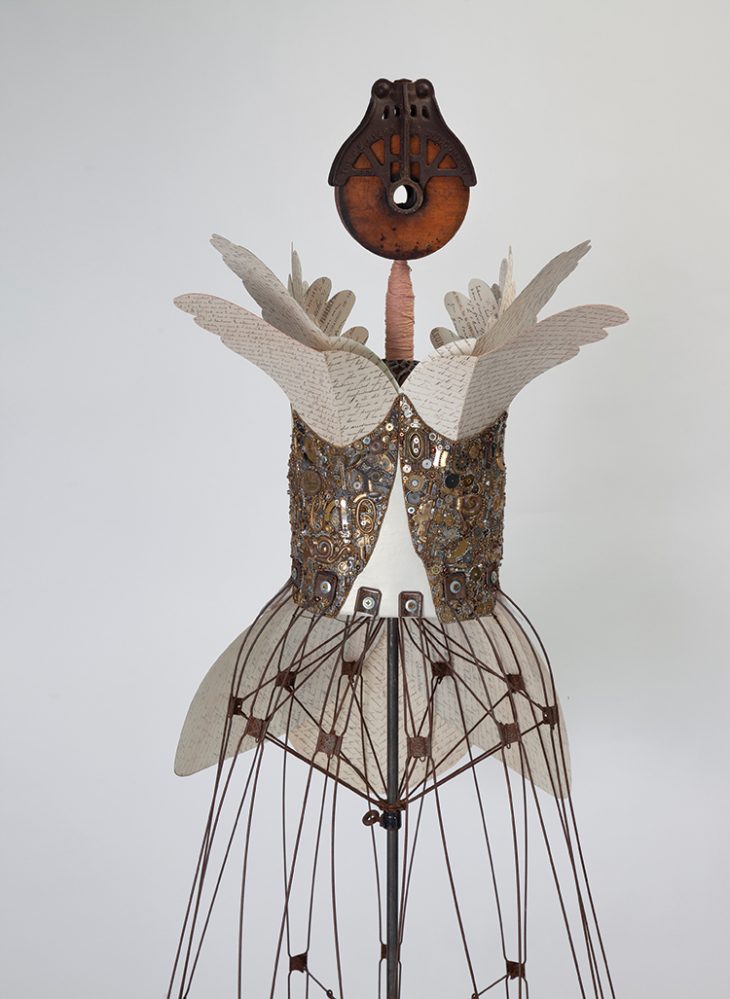
Dressed for Excess
From the discovery of an 1881 wire dress form, this futuristic/retro ‘dress’ evolved. The bodice is bead embroidered using old escutcheons, antique steel beads, watch parts, numbers, and various other found objects. I created wings and a bustle, which were covered with antique documents. The mannequin’s neck is a spindle from the historic New England spinning industry; her head is a wood and iron pulley.

One Giant Step
Size: 84″ × 36″
In 2016, we were invited to participate in a show at the Fuller Craft Museum in Brockton, MA, near Boston. I came up with a concept that would showcase Ruth’s fashion skills. The centerpiece was a woman stepping through a portal from the past into the future. Ruth created pearlized leather pants, an etched copper bustier, and a bolero jacket made from a crocheted tablecloth. The big “WOW” occurred when Ruth created these over-the-top, bead-embroidered high heel platform shoes. We didn’t know it then, but that was the birth of Shoetopia.

In These Shoes?
These high-heel platform shoes are covered with clock parts, shoe buttons, button hooks, shoehorns, shoe polish cans, subway tokens, typewriter keys, oil lamp parts, and thousands of mostly antique beads that are sewn on by hand. The six-foot-tall figure stood on a platform that elevated it three feet above the floor. This enabled museum goers to get really close to the shoes. A chorus of OMGs and flickering iPhones usually followed.
We worked together for nine months creating five pieces for the New Sole of the Old Machine: Steampunk Brockton Show. We came away from it knowing that we had created a unique style that people responded to.

Regardless how you feel about our work, you probably haven’t seen anything quite like it before. It’s hard to copy because it takes a diverse skill set and considerable patience to execute.
Ruth
Growing up on the south coast of Oregon with a creative, artistic mother gave me a strong foundation for my current artwork. She taught me a variety of techniques, many of which I continue to develop and use to this day. For a dozen years in the ‘80s and ‘90s, I used the sewing skills she taught me as I professionally created reverse appliqué leather clothing and expanded that into the sale of home goods. In the last 15 years, I’ve learned bead embroidery, paperclay sculpture of dolls and animals, metal etching, collage with antique documents, and bookmaking, which I learned from fellow artist Sharon Payne Bolton. My favorite projects are the ones that incorporate more than one skill.

Finding someone as talented as my husband, Jim, has continued to challenge me and expand my creative possibilities. I’m aware how rare it is for a couple to share such an intense desire to create art and even more rare to share the processes of creating. I feel fortunate that our skill sets don’t overlap and that we can support each other’s work.
The Highwalker
Size: 42″ × 22″ × 12″
This concept was inspired by houseplants like the sansevieria and the yucca plant. Some test pieces were created out of epoxy clay wrapped around insulated electrical wire. Epoxy clay dries as hard as a rock but is easily shaped with a rasp and is easily sanded. This shoe last is unusually large for a woman, maybe a size 12, and that gives it a real presence. The heel is made from a fire hose nozzle and a billiard ball. The platform sole is covered with embossed clay.

Jim
I was drawing before I learned to read or write. Art has always been a key component in how I identify myself. As a child in school, I was average at everything. I went to a small rural parochial school where two or three grades were taught in the same room. So when the other grade was being taught, the rest of us were supposed to study. To my delight, that same pencil that wrote out arithmetic problems could be put to better use drawing the spaceship that would help me escape to another world. Art was usually the last class of the afternoon, so my day would end on a high note.

I had the good fortune to go to a public high school that had an amazing art program in my hometown of Monett, Missouri. My luck continued when I chose to attend Missouri State University in nearby Springfield. I didn’t know the first thing about picking a college, but I landed in one with a superb art and design program. Art education transported me from rural farm boy to Vice President of a Fortune 500 company where we made games. My career was better than anything I could have imagined as a kid.
Bird Boot Bangle
Size: 14″ × 8″ × 2.5″
Created from a wooden shoe last (a hardwood maple form that leather shoes were made on through the 1970s; today, plastic forms are more commonly used). In addition, a radio dial plate, beaded purse frame, oil lamp parts, antique found objects including clock parts, music box parts, button hook, buttons, and bead embroidery round out the piece.

Shoetopia
Ruth and I have chosen many different creative paths in life, both jointly and separately. Sometimes you have to be on the path for a while before you can know what the opportunity is and that it leads somewhere. We don’t have a blueprint.
In our hometown of East Longmeadow, MA, the town center is built around a traffic rotary where seven streets converge. It sounds messy, but with a little attention and cooperation, everyone gets to where they are going. I think that’s a good analogy of how Shoetopia came to be. It took a convergence of a wide variety of skills to make this happen. Skills were developed over many years while exploring numerous creative paths. Between us, we counted seven in all, including: bead embroidery, sewing fabric and leather, paper collage, metal etching and texturing, woodworking, sculpting with paperclay, and Adobe Photoshop and Illustrator.
While we can both point to accomplishments from these various individual skills, it is the combined set that produced this unique body of work.

DETAILS of WALK IN THE CLOUDS
The upper boot consists of nine sections of quilted and beaded fabric that were lined in leather. To support the panels, a material needed to be sandwiched inside for support, and it needed to be stiff but flexible. The solution was found in a kitchen drawer — a package of thin, plastic cutting board mats. They were easy to cut with scissors, and tiny holes were punched along the outer edge where they could all be stitched together. If no solution exists, invent one.
Approximately 9 years ago, Ruth purchased a wholesale lot of about 200 Larimar cabochons from the Dominican Republic that would today retail for about $2000+. She made a couple of bracelets using some of them, while the remainder spent years in a flat drawer waiting their fate. Three boots had been completed at this point, and one day, I was looking through her collections for ideas and said, “Why not use these for one spectacular piece.” I thought, “There’s only one other person crazy enough to do something like this, and I’m married to her.” Don’t save the good stuff for that special piece; make everything you do special.

Walk in the Clouds
Size: 26″ × 6″ × 13″
This boot features about 100 Larimar cabochons in a bead-embroidered cluster. The upper section is a hand-dyed fabric that is quilted with antique steel beads; a painted wood shoe last is complemented by a gilded sole and bronze cast heel.
When you walk away from a challenge, you deny yourself the satisfaction of accomplishment.

Radio Free Texas
Size: 40″ × 9″ × 14″
Built over a wood riding boot tree, this piece features all-black vintage beads embroidered around brass letters that spell cities in Texas. The silver plate in the center is from a 1930s-era radio dial plate, which is now the home of a little bird disc jockey wearing a cowboy hat. The boot is capped with a metal oil can top and a wire antenna with a Texas star at the end.

Tortured Ballet
Size: 20″ × 15″ × 6″
A vintage shoe stretcher and ballet shoe were combined with a bead-embroidered bird house. Frayed fabric wings were added to give the appearance of a tutu.

Recent work has tended to take on a brassy brown and gold color palette. For Tortured Ballet, a white and pink color palette was chosen. White buttons, mother of pearl ornaments, and pearl beads took center stage. While the other pieces are clearly defined as shoes, in this, the shoe is merely a shape in an unconventional assemblage of textures and surfaces. This departure would carry forward into the work that followed.
We are often asked how we are able to get along with each other and work together so well. I think the biggest reason is because our skills don’t overlap. I have no idea of what to do with a sewing machine. I doubt that I would get past threading the needle. On the other hand, I’m pretty good at Photoshop, and I use it regularly to visualize and plan the pieces we build.
We have to rely on each other to make this work. At the root of all of this is a real love and admiration of each other’s work. We are both driven to do the best we are capable of and then push a little beyond that. Ruth will not hesitate to take something apart and redo it if she doesn’t like it, and I’m the same way. I’m probably the most vocal critic. Sometimes it’s easier to get along with people if you just praise them and tell them what they want to hear. If you want to be a real professional, though, you have to know how to give and take constructive criticism. I think Ruth and I both buy into the idea that the degree to which you overcome a challenge is proportional to the joy you experience in a successful result. There is nothing better than sharing that experience.

Stiletto Towers
Size: 24″ × 8″ × 12″
This high-heel boot with protruding city towers features a bead-embroidered surface made from clock parts, trinkets, and other found objects. The boot is built over a 1950s-era wooden shoe last. The heel is a brass surveyor’s plumb bob. The towers are 1950s-era brass flashlights with gas lamp parts, tire valve covers, oilers, brass finials, and a wood-handled awl.
This concept features a strong emphasis on leather as the primary material. Wood shoe lasts are easy to find on eBay, but you rarely see a high heel with a sharp pointed toe like this one. The spiked heel was a natural fit. The towers were inspired by architecture in Barcelona. We had recently found two old metal flashlights at Brimfield Antique Fair, which fit perfectly with some oil lamp parts. The cylindrical shapes are mounted over wood dowel rods, nested into the wooden structural core.

A structural core has to be created for a boot like this before the surface pieces can be attached. A series of 3/4″ plywood ovals were cut and stacked onto two steel rods that mount into the wooden shoe last base. They were coated with a layer of epoxy clay and, when dry, were shaped with rasps and sandpaper. A form is then ready for the surface pieces to be designed. Shapes are drawn and cut from paper tag stock to make the various pieces. The shapes are then attached to the boot core with rubber bands and tape and reworked until they look right. After marking and photographing the mockup, it’s disassembled, and the pieces are used as patterns.

Time to Wed
Size: 72″ × 30″
The wedding dress is made of custom printed fabric featuring the wedding vows of its creators. It is embellished with antique clock parts and bead embroidery. The crown and veil are copper with a variety of antique clock hands
Why shoes? As the saying goes: “one thing leads to another.” In 2016, there was a call for artists to submit ideas to our local Springfield Art and History Museum for an upcoming Steampunk Show. Ruth was interested, but sketching and proposals are not typically part of her process, and she asked me to help. I worked my entire career in the graphic arts field, where concept sketches and proposals were part of my everyday life. We brainstormed some ideas, and I pieced together a presentation of three fashion-related pieces highlighted by a steampunk wedding dress. All three made it into the show, and the wedding dress won a prize as the People’s Choice Award. This marked a big leap forward for the intricate combination of bead embroidery and found objects that Ruth had previously only done as jewelry. This was something truly different. Now, this unique combination of elements would embellish and take center stage on a fashion item.

I had never done anything in fashion design but now found myself doing just that. Ruth had done numerous leather jackets and other custom fashion items over the years and won awards for them; now, she was able to take my sketches and turn them into professionally fitted items. The icing on the cake, of course, was the amazing surface design and embellishments that she created to distinguish the work. While I feel Ruth deserves most of the credit for the outcome, I felt for a while that her work could be more than crafted jewelry and be elevated to works of art. I can’t say that I have doled out a lot of good advice in my time, but in this case, I was spot on. This is what I love about collaboration. Sometimes a second pair of eyes and a few words of encouragement can make big things happen. It works the other way, too. It’s great having Ruth as my personal in-house art consultant.

Dressed for Excess
From the discovery of an 1881 wire dress form, this futuristic/retro ‘dress’ evolved. The bodice is bead embroidered using old escutcheons, antique steel beads, watch parts, numbers, and various other found objects. I created wings and a bustle, which were covered with antique documents. The mannequin’s neck is a spindle from the historic New England spinning industry; her head is a wood and iron pulley.



















